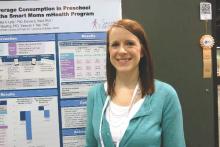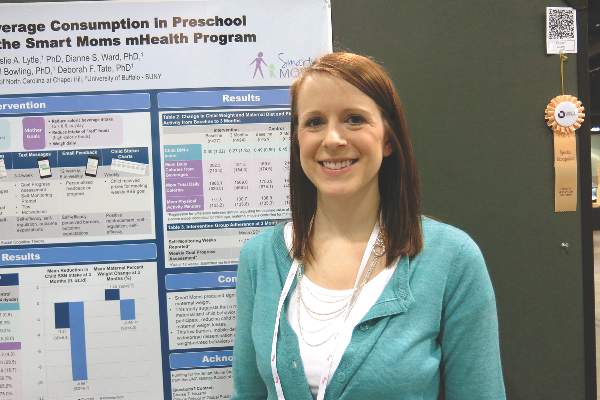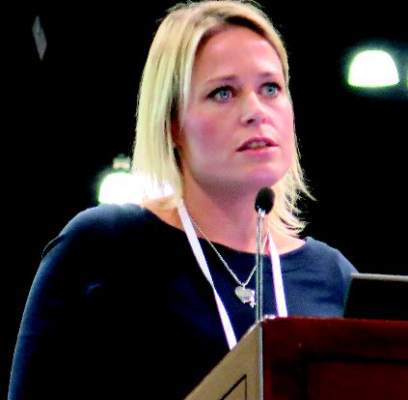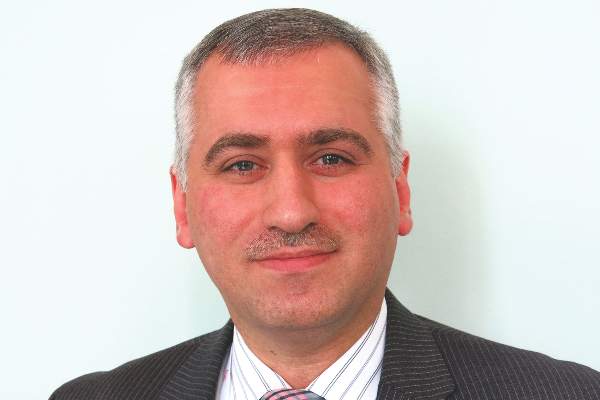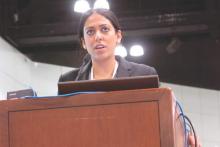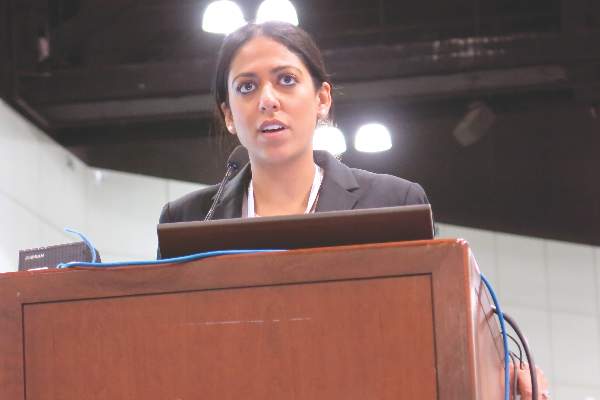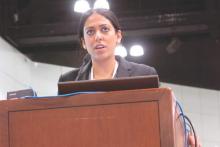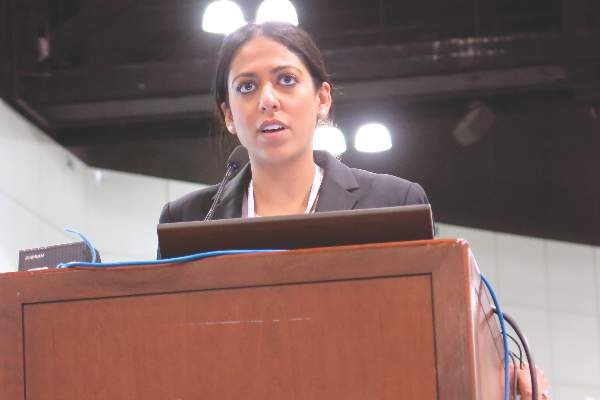User login
The Obesity Society: Annual Scientific Meeting (Obesity 2015)
Phone-based intervention helps drain sugary drinks from preschoolers’ diet
LOS ANGELES – A mobile phone–based intervention targeting both maternal and child behavior significantly cut sugar-sweetened drink consumption in preschoolers and prompted modest weight loss in Moms.
After just 3 months, the children reduced their daily intake of sugar-sweetened beverages (SSB) by 10 fluid ounces, compared with 3.2 ounces for controls, while their mothers lost 2.6% of their body weight vs. a gain of 1.4% for controls.
Both outcomes were statistically significant in regression analysis, after adjusting for child age and baseline SSB intake (P = .02) and for maternal age and race (P = .003).
On the surface, 10 fluid ounces may not sound like a lot, but at study entry these 3- to 5-year-old North Carolinian preschoolers were already consuming at least 12 ounces per day of SSBs such as 100% fruit juice, fruit drinks, sweetened tea, flavored milks, sports/energy drinks, and sodas.
“Sugar-sweetened beverages really stand out as one of the drivers of excessive weight gain in early childhood and 10 ounces is a lot for kids,” study author Ms. Brooke Nezami of the University of North Carolina in Chapel Hill, said in an interview at Obesity Week 2015. “The American Academy of Pediatrics says a serving of 100 percent fruit juice is 4 to 6 ounces, so that’s over 2 servings a day.”
Targeting mothers as the agent of change to improve child dietary behaviors may help them make healthy choices and lose weight, but getting busy moms to participate has been a huge hurdle for traditional interventions.
The Smart Moms intervention sought to reduce child SSB intake to one serving per day using 12 weekly and six bi-weekly website lessons, developed based on social cognitive theory. Children’s consumption of SSBs and mothers’ caloric beverages, high-calorie “red” foods from the Traffic Light Diet, and weight were monitored daily, with totals submitted weekly via text, Ms. Nezami, of the University of North Carolina at Chapel Hill, reported.
The mothers, who had a body mass index (BMI) of 25 kg/m2 to 50 kg/m2 at enrollment, were asked to reduce their intake of caloric beverages to less than 8 ounces per day, reduce intake of “red” foods, and to weigh themselves daily. They attended only one group meeting and then received text messages three to four times per week with tips, motivational messages, and self-monitoring prompts and 12 weekly and 6 biweekly emails with personalized feedback on their progress.
The 51 mothers and 51 children, recruited from the community, also completed in-person and on-line assessments at baseline, 3 months, and 6 months. The 6-month data are to be reported at a meeting next year.
At baseline, children in the Smart Moms intervention and wait-list control groups had an average age of 4.5 years; 40.7% vs. 58.3%, respectively, were boys; 18.5% vs. 29.2% were overweight or obese; and they consumed 15.3 ounces vs. 12.5 ounces of SSBs per day.
Mothers in the intervention and control groups had an average age of 36 years; average BMI of 33.1 kg/m2 vs. 32 kg/m2, respectively; 74% vs. 65% had an annual income of more than $75,000; and 92.6% vs. 87.5% were married.
At 3 months, daily calories from beverages declined from 252 to 131.5 among women using the intervention and rose from 169.5 to 216.7 among controls, Ms. Nezami reported in the award-winning poster.
Moms using the intervention cut their total daily calories from 1,865 to 1,569 at 3 months, compared with a small increase from 1,750 to 1,805 for controls. The differences for both outcomes were not statistically significant.
Child BMI-z scores declined from 0.30 to 0.27 with the intervention and from 0.49 to 0.45 among controls, but the difference was not significant.
Adherence to the mobile intervention remained strong at 3 months, with an average of 11 of 12 weekly self-monitoring reports and 11 of 12 weekly goal progress assessments completed, Ms. Nezami said.
“This low-burden, mobile-delivered intervention has the potential for widespread dissemination and could be an effective way to change weight-related behaviors in preschool-age children and their parents,” she concluded at the meeting, presented by the Obesity Society and American Society for Metabolic and Bariatric Surgery.
That said, some mothers may need additional encouragement from health care providers to recognize that early childhood is an opportune time to promote healthy eating habits and to reduce SSB intake.
“Most moms in the study when I presented them with the information on the risk of sugar-sweetened beverages and the calories their child was consuming from beverages were like, ‘Wow, this is something I need to change,’ ” she said. “But some participants didn’t necessarily feel at the end of it all that changing their child’s diet was as important as changing their own because they feel they’re young, they’ve still got time to create healthy diets of their own.”
The study was funded by the Gillings Dissertation Award from the University of North Carolina at Chapel Hill. Ms. Nezami reported having no conflicts of interest.
LOS ANGELES – A mobile phone–based intervention targeting both maternal and child behavior significantly cut sugar-sweetened drink consumption in preschoolers and prompted modest weight loss in Moms.
After just 3 months, the children reduced their daily intake of sugar-sweetened beverages (SSB) by 10 fluid ounces, compared with 3.2 ounces for controls, while their mothers lost 2.6% of their body weight vs. a gain of 1.4% for controls.
Both outcomes were statistically significant in regression analysis, after adjusting for child age and baseline SSB intake (P = .02) and for maternal age and race (P = .003).
On the surface, 10 fluid ounces may not sound like a lot, but at study entry these 3- to 5-year-old North Carolinian preschoolers were already consuming at least 12 ounces per day of SSBs such as 100% fruit juice, fruit drinks, sweetened tea, flavored milks, sports/energy drinks, and sodas.
“Sugar-sweetened beverages really stand out as one of the drivers of excessive weight gain in early childhood and 10 ounces is a lot for kids,” study author Ms. Brooke Nezami of the University of North Carolina in Chapel Hill, said in an interview at Obesity Week 2015. “The American Academy of Pediatrics says a serving of 100 percent fruit juice is 4 to 6 ounces, so that’s over 2 servings a day.”
Targeting mothers as the agent of change to improve child dietary behaviors may help them make healthy choices and lose weight, but getting busy moms to participate has been a huge hurdle for traditional interventions.
The Smart Moms intervention sought to reduce child SSB intake to one serving per day using 12 weekly and six bi-weekly website lessons, developed based on social cognitive theory. Children’s consumption of SSBs and mothers’ caloric beverages, high-calorie “red” foods from the Traffic Light Diet, and weight were monitored daily, with totals submitted weekly via text, Ms. Nezami, of the University of North Carolina at Chapel Hill, reported.
The mothers, who had a body mass index (BMI) of 25 kg/m2 to 50 kg/m2 at enrollment, were asked to reduce their intake of caloric beverages to less than 8 ounces per day, reduce intake of “red” foods, and to weigh themselves daily. They attended only one group meeting and then received text messages three to four times per week with tips, motivational messages, and self-monitoring prompts and 12 weekly and 6 biweekly emails with personalized feedback on their progress.
The 51 mothers and 51 children, recruited from the community, also completed in-person and on-line assessments at baseline, 3 months, and 6 months. The 6-month data are to be reported at a meeting next year.
At baseline, children in the Smart Moms intervention and wait-list control groups had an average age of 4.5 years; 40.7% vs. 58.3%, respectively, were boys; 18.5% vs. 29.2% were overweight or obese; and they consumed 15.3 ounces vs. 12.5 ounces of SSBs per day.
Mothers in the intervention and control groups had an average age of 36 years; average BMI of 33.1 kg/m2 vs. 32 kg/m2, respectively; 74% vs. 65% had an annual income of more than $75,000; and 92.6% vs. 87.5% were married.
At 3 months, daily calories from beverages declined from 252 to 131.5 among women using the intervention and rose from 169.5 to 216.7 among controls, Ms. Nezami reported in the award-winning poster.
Moms using the intervention cut their total daily calories from 1,865 to 1,569 at 3 months, compared with a small increase from 1,750 to 1,805 for controls. The differences for both outcomes were not statistically significant.
Child BMI-z scores declined from 0.30 to 0.27 with the intervention and from 0.49 to 0.45 among controls, but the difference was not significant.
Adherence to the mobile intervention remained strong at 3 months, with an average of 11 of 12 weekly self-monitoring reports and 11 of 12 weekly goal progress assessments completed, Ms. Nezami said.
“This low-burden, mobile-delivered intervention has the potential for widespread dissemination and could be an effective way to change weight-related behaviors in preschool-age children and their parents,” she concluded at the meeting, presented by the Obesity Society and American Society for Metabolic and Bariatric Surgery.
That said, some mothers may need additional encouragement from health care providers to recognize that early childhood is an opportune time to promote healthy eating habits and to reduce SSB intake.
“Most moms in the study when I presented them with the information on the risk of sugar-sweetened beverages and the calories their child was consuming from beverages were like, ‘Wow, this is something I need to change,’ ” she said. “But some participants didn’t necessarily feel at the end of it all that changing their child’s diet was as important as changing their own because they feel they’re young, they’ve still got time to create healthy diets of their own.”
The study was funded by the Gillings Dissertation Award from the University of North Carolina at Chapel Hill. Ms. Nezami reported having no conflicts of interest.
LOS ANGELES – A mobile phone–based intervention targeting both maternal and child behavior significantly cut sugar-sweetened drink consumption in preschoolers and prompted modest weight loss in Moms.
After just 3 months, the children reduced their daily intake of sugar-sweetened beverages (SSB) by 10 fluid ounces, compared with 3.2 ounces for controls, while their mothers lost 2.6% of their body weight vs. a gain of 1.4% for controls.
Both outcomes were statistically significant in regression analysis, after adjusting for child age and baseline SSB intake (P = .02) and for maternal age and race (P = .003).
On the surface, 10 fluid ounces may not sound like a lot, but at study entry these 3- to 5-year-old North Carolinian preschoolers were already consuming at least 12 ounces per day of SSBs such as 100% fruit juice, fruit drinks, sweetened tea, flavored milks, sports/energy drinks, and sodas.
“Sugar-sweetened beverages really stand out as one of the drivers of excessive weight gain in early childhood and 10 ounces is a lot for kids,” study author Ms. Brooke Nezami of the University of North Carolina in Chapel Hill, said in an interview at Obesity Week 2015. “The American Academy of Pediatrics says a serving of 100 percent fruit juice is 4 to 6 ounces, so that’s over 2 servings a day.”
Targeting mothers as the agent of change to improve child dietary behaviors may help them make healthy choices and lose weight, but getting busy moms to participate has been a huge hurdle for traditional interventions.
The Smart Moms intervention sought to reduce child SSB intake to one serving per day using 12 weekly and six bi-weekly website lessons, developed based on social cognitive theory. Children’s consumption of SSBs and mothers’ caloric beverages, high-calorie “red” foods from the Traffic Light Diet, and weight were monitored daily, with totals submitted weekly via text, Ms. Nezami, of the University of North Carolina at Chapel Hill, reported.
The mothers, who had a body mass index (BMI) of 25 kg/m2 to 50 kg/m2 at enrollment, were asked to reduce their intake of caloric beverages to less than 8 ounces per day, reduce intake of “red” foods, and to weigh themselves daily. They attended only one group meeting and then received text messages three to four times per week with tips, motivational messages, and self-monitoring prompts and 12 weekly and 6 biweekly emails with personalized feedback on their progress.
The 51 mothers and 51 children, recruited from the community, also completed in-person and on-line assessments at baseline, 3 months, and 6 months. The 6-month data are to be reported at a meeting next year.
At baseline, children in the Smart Moms intervention and wait-list control groups had an average age of 4.5 years; 40.7% vs. 58.3%, respectively, were boys; 18.5% vs. 29.2% were overweight or obese; and they consumed 15.3 ounces vs. 12.5 ounces of SSBs per day.
Mothers in the intervention and control groups had an average age of 36 years; average BMI of 33.1 kg/m2 vs. 32 kg/m2, respectively; 74% vs. 65% had an annual income of more than $75,000; and 92.6% vs. 87.5% were married.
At 3 months, daily calories from beverages declined from 252 to 131.5 among women using the intervention and rose from 169.5 to 216.7 among controls, Ms. Nezami reported in the award-winning poster.
Moms using the intervention cut their total daily calories from 1,865 to 1,569 at 3 months, compared with a small increase from 1,750 to 1,805 for controls. The differences for both outcomes were not statistically significant.
Child BMI-z scores declined from 0.30 to 0.27 with the intervention and from 0.49 to 0.45 among controls, but the difference was not significant.
Adherence to the mobile intervention remained strong at 3 months, with an average of 11 of 12 weekly self-monitoring reports and 11 of 12 weekly goal progress assessments completed, Ms. Nezami said.
“This low-burden, mobile-delivered intervention has the potential for widespread dissemination and could be an effective way to change weight-related behaviors in preschool-age children and their parents,” she concluded at the meeting, presented by the Obesity Society and American Society for Metabolic and Bariatric Surgery.
That said, some mothers may need additional encouragement from health care providers to recognize that early childhood is an opportune time to promote healthy eating habits and to reduce SSB intake.
“Most moms in the study when I presented them with the information on the risk of sugar-sweetened beverages and the calories their child was consuming from beverages were like, ‘Wow, this is something I need to change,’ ” she said. “But some participants didn’t necessarily feel at the end of it all that changing their child’s diet was as important as changing their own because they feel they’re young, they’ve still got time to create healthy diets of their own.”
The study was funded by the Gillings Dissertation Award from the University of North Carolina at Chapel Hill. Ms. Nezami reported having no conflicts of interest.
AT OBESITY WEEK 2015
Key clinical point: A smartphone intervention targeting maternal and child behavior can be effective in engaging mothers to participate, reduce their children’s sugar-sweetened beverage consumption, and reduce maternal weight.
Major finding: Daily sugar-sweetened beverage consumption was significantly reduced with the mobile intervention vs. controls (10 oz. vs. 3.2 oz; adjusted P = .02).
Data source: Prospective, randomized study in 51 mother-child dyads.
Disclosures: The study was funded by the Gillings Dissertation Award from the University of North Carolina at Chapel Hill. Ms. Nezami reported having no conflicts of interest.
Adolescents still struggling mentally years after bariatric surgery
LOS ANGELES – One in five adolescents report poor mental health 2 years after gastric bypass surgery, a Swedish study shows.
“There is an unmet need for psychiatric and psychological treatment in adolescents, and 20% is a much higher figure than you find in adults,” Kajsa Järvholm of Lund University, Sweden, said at Obesity Week 2015.
Notably, weight loss did not differ during follow-up between adolescents with poor mental health (PMH) and those with average or good mental health.
Girls were more likely than were boys to report PMH (14 vs. 2; P = .053), but no significant age difference was found.
Prior research has shown that adolescents seeking bariatric surgery have impaired mental health compared with population norms, but most adolescents experience an improvement after surgery.
A recent systematic review of psychological and social outcomes in adolescents undergoing bariatric surgery found overall quality of life improved after surgery, regardless of the surgical type, with peak improvement at months 6 to 12 (Clin Obes. 2015 Nov. 6. doi: 10.1111/cob.12119).
The current study involved 82 adolescents who were part of the larger Adolescent Morbid Obesity Surgery (AMOS) study cohort. At the time of surgery, the average age of the patients was 16.8 years and the average body mass index was 45.4 kg/m2. Two-thirds (67%) were girls.
The adolescents were assessed by self-report questionnaires at baseline, 1 year, and 2 years after laparoscopic bariatric surgery. Standardized cutoffs on two different variables, depression and obesity-related problems, were used to classify adolescents as having a PMH or average and good mental health 2 years after surgery.
Adolescents with PMH at 2 years post surgery reported significantly more symptoms of anxiety (P = .004) and depression (P = .028) already before surgery, Ms. Järvholm said.
One year after surgery, more differences were observed. Adolescents with PMH, in addition to reporting more symptoms of anxiety (P less than .0001) and depression (P = .003), also reported more anger (P = .005) and obesity-related problems (P = .006) than did adolescents with an average or good mental health.
No differences were seen at this time in self-concept or disruptive behavior, she said.
Two years after surgery, all measured aspects of mental health were worse in adolescents with PMH (all P values less than .0001), Ms. Järvholm said.
“Preoperative identification is difficult since most variables do not differ between groups, but we should take extra care with adolescents with more anxiety and more depression already before surgery,” she said at the meeting, presented by the Obesity Society and American Society for Metabolic and Bariatric Surgery.
LOS ANGELES – One in five adolescents report poor mental health 2 years after gastric bypass surgery, a Swedish study shows.
“There is an unmet need for psychiatric and psychological treatment in adolescents, and 20% is a much higher figure than you find in adults,” Kajsa Järvholm of Lund University, Sweden, said at Obesity Week 2015.
Notably, weight loss did not differ during follow-up between adolescents with poor mental health (PMH) and those with average or good mental health.
Girls were more likely than were boys to report PMH (14 vs. 2; P = .053), but no significant age difference was found.
Prior research has shown that adolescents seeking bariatric surgery have impaired mental health compared with population norms, but most adolescents experience an improvement after surgery.
A recent systematic review of psychological and social outcomes in adolescents undergoing bariatric surgery found overall quality of life improved after surgery, regardless of the surgical type, with peak improvement at months 6 to 12 (Clin Obes. 2015 Nov. 6. doi: 10.1111/cob.12119).
The current study involved 82 adolescents who were part of the larger Adolescent Morbid Obesity Surgery (AMOS) study cohort. At the time of surgery, the average age of the patients was 16.8 years and the average body mass index was 45.4 kg/m2. Two-thirds (67%) were girls.
The adolescents were assessed by self-report questionnaires at baseline, 1 year, and 2 years after laparoscopic bariatric surgery. Standardized cutoffs on two different variables, depression and obesity-related problems, were used to classify adolescents as having a PMH or average and good mental health 2 years after surgery.
Adolescents with PMH at 2 years post surgery reported significantly more symptoms of anxiety (P = .004) and depression (P = .028) already before surgery, Ms. Järvholm said.
One year after surgery, more differences were observed. Adolescents with PMH, in addition to reporting more symptoms of anxiety (P less than .0001) and depression (P = .003), also reported more anger (P = .005) and obesity-related problems (P = .006) than did adolescents with an average or good mental health.
No differences were seen at this time in self-concept or disruptive behavior, she said.
Two years after surgery, all measured aspects of mental health were worse in adolescents with PMH (all P values less than .0001), Ms. Järvholm said.
“Preoperative identification is difficult since most variables do not differ between groups, but we should take extra care with adolescents with more anxiety and more depression already before surgery,” she said at the meeting, presented by the Obesity Society and American Society for Metabolic and Bariatric Surgery.
LOS ANGELES – One in five adolescents report poor mental health 2 years after gastric bypass surgery, a Swedish study shows.
“There is an unmet need for psychiatric and psychological treatment in adolescents, and 20% is a much higher figure than you find in adults,” Kajsa Järvholm of Lund University, Sweden, said at Obesity Week 2015.
Notably, weight loss did not differ during follow-up between adolescents with poor mental health (PMH) and those with average or good mental health.
Girls were more likely than were boys to report PMH (14 vs. 2; P = .053), but no significant age difference was found.
Prior research has shown that adolescents seeking bariatric surgery have impaired mental health compared with population norms, but most adolescents experience an improvement after surgery.
A recent systematic review of psychological and social outcomes in adolescents undergoing bariatric surgery found overall quality of life improved after surgery, regardless of the surgical type, with peak improvement at months 6 to 12 (Clin Obes. 2015 Nov. 6. doi: 10.1111/cob.12119).
The current study involved 82 adolescents who were part of the larger Adolescent Morbid Obesity Surgery (AMOS) study cohort. At the time of surgery, the average age of the patients was 16.8 years and the average body mass index was 45.4 kg/m2. Two-thirds (67%) were girls.
The adolescents were assessed by self-report questionnaires at baseline, 1 year, and 2 years after laparoscopic bariatric surgery. Standardized cutoffs on two different variables, depression and obesity-related problems, were used to classify adolescents as having a PMH or average and good mental health 2 years after surgery.
Adolescents with PMH at 2 years post surgery reported significantly more symptoms of anxiety (P = .004) and depression (P = .028) already before surgery, Ms. Järvholm said.
One year after surgery, more differences were observed. Adolescents with PMH, in addition to reporting more symptoms of anxiety (P less than .0001) and depression (P = .003), also reported more anger (P = .005) and obesity-related problems (P = .006) than did adolescents with an average or good mental health.
No differences were seen at this time in self-concept or disruptive behavior, she said.
Two years after surgery, all measured aspects of mental health were worse in adolescents with PMH (all P values less than .0001), Ms. Järvholm said.
“Preoperative identification is difficult since most variables do not differ between groups, but we should take extra care with adolescents with more anxiety and more depression already before surgery,” she said at the meeting, presented by the Obesity Society and American Society for Metabolic and Bariatric Surgery.
AT OBESITY WEEK 2015
Key clinical point: A substantial number of adolescents report poor mental health 2 years after bariatric surgery.
Major finding: One in five adolescents report poor mental health 2 years after bariatric surgery.
Data source: Retrospective study of 82 adolescents.
Disclosures: The authors reported having no conflicts of interest.
Complications climb with revisional surgery after adjustable gastric banding
LOS ANGELES – Revisional surgery after failed adjustable gastric banding (AGB) is associated with an increased risk of adverse events and resource utilization, according to Dr. Steven Poplawski, medical director for Barix Clinics in Ypsilanti, Mich.
His conclusion is based on safety outcomes at 30 days for 55,237 patients who underwent primary bariatric surgery and 1,417 patients who underwent AGB revision between June 2006 and July 2015 in the Michigan Bariatric Surgery Collaborative. Patients were excluded from the retrospective evaluation if they had urgent/emergent procedures or more than one previous bariatric operation.
The primary bariatric surgery was Roux-en-Y gastric bypass (RYGB) in 43%, sleeve gastrectomy in 37%, AGB in 19%, and biliopancreatic diversion with duodenal switch (BPD/DS) in 1%.
The patients turned to AGB revision for the same reasons that have prompted its dramatic decline in utilization: weight loss failure (38%), band complications (33%), or both (29%). AGB revisional procedures were sleeve gastrectomy in 54%, RYGB in 35%, AGB in 9%, and BPD/DS in 2%.
Patients undergoing band-to-RYGB conversions had significantly more serious complications, compared with primary RYGB procedures (10.2% vs. 4.4%; P less than .0001), reoperations (5.1% vs. 2.3%; P = .0001), and hospital readmissions (10% vs. 7.3%; P = .0064), and a nonsignificant trend toward more leaks (1.3% vs. 0.7%; P = .13), Dr. Poplawski reported.
Patients undergoing band-to-sleeve conversions had significantly more serious complications when compared with primary sleeve gastrectomy (5% vs. 1.8%; P less than .0001), reoperations (3.3% vs. 1%; P less than .0001), and leaks (1.5% vs. 0.5%; P = .0001), and a nonsignificant trend toward more readmissions (7.7% vs. 4.6%; P = .0685).
Outcomes were not reported for the smaller number of patients undergoing AGB-to-AGB or AGB-to-BPD/DS conversions.
A secondary analysis was performed examining a one-stage versus a two-stage procedure in 525 patients undergoing revisional surgery for weight loss failure only. The only safety outcome to show a significant difference at 30 days was hospital readmissions in the RYGB-conversion group, favoring the one-stage over the two-stage procedure (7.1% vs. 11.5%; P = .0164).
“Clearly, the benefit of a one-stage procedure versus a two-stage procedure is unclear in the way it was studied here,” Dr. Poplawski said at Obesity Week 2015, presented by the Obesity Society and the American Society for Metabolic and Bariatric Surgery.
“You can read in some reports that [surgeons] do all [of these procedures as] two-stage because they think it’s safer, but I don’t know that there’s much support for that here. I think it’s reasonable to get most of them done in one stage because there’s also two hospitalizations, two periods of convalescence, and when we talk about the complications of the two-stage operation we aren’t even including the costs to remove the initial band, which are not insignificant,” he noted.
Dr. Raul Rosenthal of the Cleveland Clinic in Weston, Fla., who comoderated the session, said the takeaway message is that “reoperative surgery pays a price. No matter how you look at it, one stage, two stages, with bands or sleeve, you’re going to get in trouble.”
LOS ANGELES – Revisional surgery after failed adjustable gastric banding (AGB) is associated with an increased risk of adverse events and resource utilization, according to Dr. Steven Poplawski, medical director for Barix Clinics in Ypsilanti, Mich.
His conclusion is based on safety outcomes at 30 days for 55,237 patients who underwent primary bariatric surgery and 1,417 patients who underwent AGB revision between June 2006 and July 2015 in the Michigan Bariatric Surgery Collaborative. Patients were excluded from the retrospective evaluation if they had urgent/emergent procedures or more than one previous bariatric operation.
The primary bariatric surgery was Roux-en-Y gastric bypass (RYGB) in 43%, sleeve gastrectomy in 37%, AGB in 19%, and biliopancreatic diversion with duodenal switch (BPD/DS) in 1%.
The patients turned to AGB revision for the same reasons that have prompted its dramatic decline in utilization: weight loss failure (38%), band complications (33%), or both (29%). AGB revisional procedures were sleeve gastrectomy in 54%, RYGB in 35%, AGB in 9%, and BPD/DS in 2%.
Patients undergoing band-to-RYGB conversions had significantly more serious complications, compared with primary RYGB procedures (10.2% vs. 4.4%; P less than .0001), reoperations (5.1% vs. 2.3%; P = .0001), and hospital readmissions (10% vs. 7.3%; P = .0064), and a nonsignificant trend toward more leaks (1.3% vs. 0.7%; P = .13), Dr. Poplawski reported.
Patients undergoing band-to-sleeve conversions had significantly more serious complications when compared with primary sleeve gastrectomy (5% vs. 1.8%; P less than .0001), reoperations (3.3% vs. 1%; P less than .0001), and leaks (1.5% vs. 0.5%; P = .0001), and a nonsignificant trend toward more readmissions (7.7% vs. 4.6%; P = .0685).
Outcomes were not reported for the smaller number of patients undergoing AGB-to-AGB or AGB-to-BPD/DS conversions.
A secondary analysis was performed examining a one-stage versus a two-stage procedure in 525 patients undergoing revisional surgery for weight loss failure only. The only safety outcome to show a significant difference at 30 days was hospital readmissions in the RYGB-conversion group, favoring the one-stage over the two-stage procedure (7.1% vs. 11.5%; P = .0164).
“Clearly, the benefit of a one-stage procedure versus a two-stage procedure is unclear in the way it was studied here,” Dr. Poplawski said at Obesity Week 2015, presented by the Obesity Society and the American Society for Metabolic and Bariatric Surgery.
“You can read in some reports that [surgeons] do all [of these procedures as] two-stage because they think it’s safer, but I don’t know that there’s much support for that here. I think it’s reasonable to get most of them done in one stage because there’s also two hospitalizations, two periods of convalescence, and when we talk about the complications of the two-stage operation we aren’t even including the costs to remove the initial band, which are not insignificant,” he noted.
Dr. Raul Rosenthal of the Cleveland Clinic in Weston, Fla., who comoderated the session, said the takeaway message is that “reoperative surgery pays a price. No matter how you look at it, one stage, two stages, with bands or sleeve, you’re going to get in trouble.”
LOS ANGELES – Revisional surgery after failed adjustable gastric banding (AGB) is associated with an increased risk of adverse events and resource utilization, according to Dr. Steven Poplawski, medical director for Barix Clinics in Ypsilanti, Mich.
His conclusion is based on safety outcomes at 30 days for 55,237 patients who underwent primary bariatric surgery and 1,417 patients who underwent AGB revision between June 2006 and July 2015 in the Michigan Bariatric Surgery Collaborative. Patients were excluded from the retrospective evaluation if they had urgent/emergent procedures or more than one previous bariatric operation.
The primary bariatric surgery was Roux-en-Y gastric bypass (RYGB) in 43%, sleeve gastrectomy in 37%, AGB in 19%, and biliopancreatic diversion with duodenal switch (BPD/DS) in 1%.
The patients turned to AGB revision for the same reasons that have prompted its dramatic decline in utilization: weight loss failure (38%), band complications (33%), or both (29%). AGB revisional procedures were sleeve gastrectomy in 54%, RYGB in 35%, AGB in 9%, and BPD/DS in 2%.
Patients undergoing band-to-RYGB conversions had significantly more serious complications, compared with primary RYGB procedures (10.2% vs. 4.4%; P less than .0001), reoperations (5.1% vs. 2.3%; P = .0001), and hospital readmissions (10% vs. 7.3%; P = .0064), and a nonsignificant trend toward more leaks (1.3% vs. 0.7%; P = .13), Dr. Poplawski reported.
Patients undergoing band-to-sleeve conversions had significantly more serious complications when compared with primary sleeve gastrectomy (5% vs. 1.8%; P less than .0001), reoperations (3.3% vs. 1%; P less than .0001), and leaks (1.5% vs. 0.5%; P = .0001), and a nonsignificant trend toward more readmissions (7.7% vs. 4.6%; P = .0685).
Outcomes were not reported for the smaller number of patients undergoing AGB-to-AGB or AGB-to-BPD/DS conversions.
A secondary analysis was performed examining a one-stage versus a two-stage procedure in 525 patients undergoing revisional surgery for weight loss failure only. The only safety outcome to show a significant difference at 30 days was hospital readmissions in the RYGB-conversion group, favoring the one-stage over the two-stage procedure (7.1% vs. 11.5%; P = .0164).
“Clearly, the benefit of a one-stage procedure versus a two-stage procedure is unclear in the way it was studied here,” Dr. Poplawski said at Obesity Week 2015, presented by the Obesity Society and the American Society for Metabolic and Bariatric Surgery.
“You can read in some reports that [surgeons] do all [of these procedures as] two-stage because they think it’s safer, but I don’t know that there’s much support for that here. I think it’s reasonable to get most of them done in one stage because there’s also two hospitalizations, two periods of convalescence, and when we talk about the complications of the two-stage operation we aren’t even including the costs to remove the initial band, which are not insignificant,” he noted.
Dr. Raul Rosenthal of the Cleveland Clinic in Weston, Fla., who comoderated the session, said the takeaway message is that “reoperative surgery pays a price. No matter how you look at it, one stage, two stages, with bands or sleeve, you’re going to get in trouble.”
AT OBESITY WEEK 2015
Key clinical point: Conversions of adjustable gastric bands are associated with more 30-day adverse events.
Major finding: Serious complications were higher in AGB–to–Roux-en-Y gastric bypass conversions than in primary RYGB (10.2% vs. 4.4%; P less than .0001) and in AGB-to-sleeve gastrectomy conversions, compared with primary sleeves (5% vs. 1.8%; P less than .0001).
Data source: Retrospective study of 55,237 patients who underwent primary bariatric surgery and 1,417 patients who underwent adjustable gastric band revision.
Disclosures: Dr. Poplawski reported having no disclosures.
Short-term adverse events modest after bariatric surgery in slimmer diabetics
LOS ANGELES – A nationwide analysis shows modest early morbidity and low mortality following bariatric surgery in patients with type 2 diabetes who are not morbidly obese.
At 30 days’ follow-up among 1,003 patients, the composite complication rate, defined as the presence of any of 16 adverse events, was 4.2%; the reoperation rate was 1.6%; and two patients (0.2%) died.
“A 2-hour surgical procedure requiring a 2-day hospital stay that is associated with low morbidity and mortality can lead to remission of a chronic, progressive, and disabling disease,” lead author Dr. Ali Aminian of the Cleveland Clinic said at Obesity Week 2015.
“Based on these findings, bariatric surgery can be considered a relatively safe option for managing type 2 diabetes in patients with mild obesity.”
The analysis included adults with a body mass index of at least 25 kg/m2, but less than 35 kg/m2 (mean, 33 kg/m2).
These data are important because most patients with type 2 diabetes fall into this BMI category, he said.
Most of the patients were women (74.3%), 40% were using insulin, 78% had hypertension, and 9% had cardiac disease, according to the analysis, drawn from the American College of Surgery National Surgical Quality Improvement Program 2005-2013 database.
Roux-en-Y bypass was performed in 574 patients, adjustable gastric banding in 227, sleeve gastrectomy in 189, and duodenal switch in 13.
The most common adverse events overall were blood transfusion and reoperation (both 1.6%), a hospital stay longer than 7 days (0.6%), and organ space surgical-site infection (0.5%).
Composite morbidity and mortality was highest in the Roux-en-Y bypass group, compared with the adjustable banding and sleeve groups (5% vs. 3.1% vs. 3.2%, respectively), Dr. Aminian said at the meeting, presented by the Obesity Society and the American Society for Metabolic and Bariatric Surgery.
Only 3 of 46 patients with a BMI of less than 30 kg/m2 had an adverse event.
Available randomized controlled trials can’t clearly resolve the safety concerns of bariatric surgery in the subgroup of patients with type 2 diabetes who are overweight and mildly obese because such small trials are unlikely to reveal uncommon but clinically serious complications, Dr. Aminian said. In addition, many of the trials have screened out low-BMI and high-risk patients.
Those in attendance at the presentation, however, weren’t entirely convinced the current analysis could allay all safety concerns.
Session comoderator Dr. Daniel Cottam, a bariatric surgeon in group practice in Salt Lake City, said, “I like the summary; however, the use of the word ‘safe’ can be taken to mean a lot of things. It’s one of those squishy words.”
Though the authors have shown that bariatric surgery can be performed in diabetics with a low BMI, in order to say it is safe, the comparison needs to be drawn to the all-cause mortality for these patients in the general population and with other surgical procedures.
“That would be useful in the manuscript because as we approach our patients, we want to be able to say, ‘Listen, if you live with diabetes and a BMI of 25-35 for 5 years, this is your all-cause mortality, and surgery is going to save your life, not hurt it,’ ” Dr. Cottam said.
Along the same lines, Dr. Harvey Sugerman emeritus professor of surgery at Virginia Commonwealth University in Richmond, commented, “Like the old days of routinely operating on any patient with diabetes and gallstones, the data were that just having one death in a young person and the quality-of-life-years lost, it would take you thousands of gallbladders to make up for that one death.”
Dr. Sugarmen also asked for details on the deaths including where they occurred, in whom, and whether the centers were inexperienced.
Dr. Aminian could not recall at the time, but in an interview with this news organization said one death was in a 61-year-old with a history of cardiac disease and chronic kidney failure secondary to insulin-dependent diabetes who developed postop bleeding after gastric bypass. The second was in a 59-year-old patient, again on insulin, who was discharged without problems after gastric bypass, but died within 30 days after surgery.
Although most serious complications occur in this period, the main limitation of the study is that the dataset does not capture adverse events beyond 30 days after surgery, which can lead to underestimation of real risk, Dr. Aminian told the crowd.
“Further large clinical studies on long-term safety and efficacy outcomes of bariatric surgery in patients with type 2 diabetes and low BMI are warranted,” he said.
LOS ANGELES – A nationwide analysis shows modest early morbidity and low mortality following bariatric surgery in patients with type 2 diabetes who are not morbidly obese.
At 30 days’ follow-up among 1,003 patients, the composite complication rate, defined as the presence of any of 16 adverse events, was 4.2%; the reoperation rate was 1.6%; and two patients (0.2%) died.
“A 2-hour surgical procedure requiring a 2-day hospital stay that is associated with low morbidity and mortality can lead to remission of a chronic, progressive, and disabling disease,” lead author Dr. Ali Aminian of the Cleveland Clinic said at Obesity Week 2015.
“Based on these findings, bariatric surgery can be considered a relatively safe option for managing type 2 diabetes in patients with mild obesity.”
The analysis included adults with a body mass index of at least 25 kg/m2, but less than 35 kg/m2 (mean, 33 kg/m2).
These data are important because most patients with type 2 diabetes fall into this BMI category, he said.
Most of the patients were women (74.3%), 40% were using insulin, 78% had hypertension, and 9% had cardiac disease, according to the analysis, drawn from the American College of Surgery National Surgical Quality Improvement Program 2005-2013 database.
Roux-en-Y bypass was performed in 574 patients, adjustable gastric banding in 227, sleeve gastrectomy in 189, and duodenal switch in 13.
The most common adverse events overall were blood transfusion and reoperation (both 1.6%), a hospital stay longer than 7 days (0.6%), and organ space surgical-site infection (0.5%).
Composite morbidity and mortality was highest in the Roux-en-Y bypass group, compared with the adjustable banding and sleeve groups (5% vs. 3.1% vs. 3.2%, respectively), Dr. Aminian said at the meeting, presented by the Obesity Society and the American Society for Metabolic and Bariatric Surgery.
Only 3 of 46 patients with a BMI of less than 30 kg/m2 had an adverse event.
Available randomized controlled trials can’t clearly resolve the safety concerns of bariatric surgery in the subgroup of patients with type 2 diabetes who are overweight and mildly obese because such small trials are unlikely to reveal uncommon but clinically serious complications, Dr. Aminian said. In addition, many of the trials have screened out low-BMI and high-risk patients.
Those in attendance at the presentation, however, weren’t entirely convinced the current analysis could allay all safety concerns.
Session comoderator Dr. Daniel Cottam, a bariatric surgeon in group practice in Salt Lake City, said, “I like the summary; however, the use of the word ‘safe’ can be taken to mean a lot of things. It’s one of those squishy words.”
Though the authors have shown that bariatric surgery can be performed in diabetics with a low BMI, in order to say it is safe, the comparison needs to be drawn to the all-cause mortality for these patients in the general population and with other surgical procedures.
“That would be useful in the manuscript because as we approach our patients, we want to be able to say, ‘Listen, if you live with diabetes and a BMI of 25-35 for 5 years, this is your all-cause mortality, and surgery is going to save your life, not hurt it,’ ” Dr. Cottam said.
Along the same lines, Dr. Harvey Sugerman emeritus professor of surgery at Virginia Commonwealth University in Richmond, commented, “Like the old days of routinely operating on any patient with diabetes and gallstones, the data were that just having one death in a young person and the quality-of-life-years lost, it would take you thousands of gallbladders to make up for that one death.”
Dr. Sugarmen also asked for details on the deaths including where they occurred, in whom, and whether the centers were inexperienced.
Dr. Aminian could not recall at the time, but in an interview with this news organization said one death was in a 61-year-old with a history of cardiac disease and chronic kidney failure secondary to insulin-dependent diabetes who developed postop bleeding after gastric bypass. The second was in a 59-year-old patient, again on insulin, who was discharged without problems after gastric bypass, but died within 30 days after surgery.
Although most serious complications occur in this period, the main limitation of the study is that the dataset does not capture adverse events beyond 30 days after surgery, which can lead to underestimation of real risk, Dr. Aminian told the crowd.
“Further large clinical studies on long-term safety and efficacy outcomes of bariatric surgery in patients with type 2 diabetes and low BMI are warranted,” he said.
LOS ANGELES – A nationwide analysis shows modest early morbidity and low mortality following bariatric surgery in patients with type 2 diabetes who are not morbidly obese.
At 30 days’ follow-up among 1,003 patients, the composite complication rate, defined as the presence of any of 16 adverse events, was 4.2%; the reoperation rate was 1.6%; and two patients (0.2%) died.
“A 2-hour surgical procedure requiring a 2-day hospital stay that is associated with low morbidity and mortality can lead to remission of a chronic, progressive, and disabling disease,” lead author Dr. Ali Aminian of the Cleveland Clinic said at Obesity Week 2015.
“Based on these findings, bariatric surgery can be considered a relatively safe option for managing type 2 diabetes in patients with mild obesity.”
The analysis included adults with a body mass index of at least 25 kg/m2, but less than 35 kg/m2 (mean, 33 kg/m2).
These data are important because most patients with type 2 diabetes fall into this BMI category, he said.
Most of the patients were women (74.3%), 40% were using insulin, 78% had hypertension, and 9% had cardiac disease, according to the analysis, drawn from the American College of Surgery National Surgical Quality Improvement Program 2005-2013 database.
Roux-en-Y bypass was performed in 574 patients, adjustable gastric banding in 227, sleeve gastrectomy in 189, and duodenal switch in 13.
The most common adverse events overall were blood transfusion and reoperation (both 1.6%), a hospital stay longer than 7 days (0.6%), and organ space surgical-site infection (0.5%).
Composite morbidity and mortality was highest in the Roux-en-Y bypass group, compared with the adjustable banding and sleeve groups (5% vs. 3.1% vs. 3.2%, respectively), Dr. Aminian said at the meeting, presented by the Obesity Society and the American Society for Metabolic and Bariatric Surgery.
Only 3 of 46 patients with a BMI of less than 30 kg/m2 had an adverse event.
Available randomized controlled trials can’t clearly resolve the safety concerns of bariatric surgery in the subgroup of patients with type 2 diabetes who are overweight and mildly obese because such small trials are unlikely to reveal uncommon but clinically serious complications, Dr. Aminian said. In addition, many of the trials have screened out low-BMI and high-risk patients.
Those in attendance at the presentation, however, weren’t entirely convinced the current analysis could allay all safety concerns.
Session comoderator Dr. Daniel Cottam, a bariatric surgeon in group practice in Salt Lake City, said, “I like the summary; however, the use of the word ‘safe’ can be taken to mean a lot of things. It’s one of those squishy words.”
Though the authors have shown that bariatric surgery can be performed in diabetics with a low BMI, in order to say it is safe, the comparison needs to be drawn to the all-cause mortality for these patients in the general population and with other surgical procedures.
“That would be useful in the manuscript because as we approach our patients, we want to be able to say, ‘Listen, if you live with diabetes and a BMI of 25-35 for 5 years, this is your all-cause mortality, and surgery is going to save your life, not hurt it,’ ” Dr. Cottam said.
Along the same lines, Dr. Harvey Sugerman emeritus professor of surgery at Virginia Commonwealth University in Richmond, commented, “Like the old days of routinely operating on any patient with diabetes and gallstones, the data were that just having one death in a young person and the quality-of-life-years lost, it would take you thousands of gallbladders to make up for that one death.”
Dr. Sugarmen also asked for details on the deaths including where they occurred, in whom, and whether the centers were inexperienced.
Dr. Aminian could not recall at the time, but in an interview with this news organization said one death was in a 61-year-old with a history of cardiac disease and chronic kidney failure secondary to insulin-dependent diabetes who developed postop bleeding after gastric bypass. The second was in a 59-year-old patient, again on insulin, who was discharged without problems after gastric bypass, but died within 30 days after surgery.
Although most serious complications occur in this period, the main limitation of the study is that the dataset does not capture adverse events beyond 30 days after surgery, which can lead to underestimation of real risk, Dr. Aminian told the crowd.
“Further large clinical studies on long-term safety and efficacy outcomes of bariatric surgery in patients with type 2 diabetes and low BMI are warranted,” he said.
AT OBESITY WEEK 2015
Key clinical point: Short-term outcomes suggest that bariatric surgery may be safe in patients with type 2 diabetes who are not morbidly obese.
Major finding: The composite complication rate was 4.2%, 1.6% required reoperation, and two patients (0.2%) died.
Data source: An ACS-NSQIP safety analysis of 1,003 diabetics undergoing bariatric surgery.
Disclosures: The authors reported having no relevant financial conflicts.
After bariatric surgery, pain and disability decline
LOS ANGELES – In the 3 years following bariatric surgery, 50%-70% of adults will experience clinically meaningful easing of bodily pain and improved physical function, a collaborative study shows.
Further, 75% of patients with severe knee and hip pain or disability had lessening of symptoms indicative of osteoarthritis, Wendy C. King, Ph.D., of the University of Pittsburgh Graduate School of Public Health, reported at Obesity Week 2015.
The study also sheds new light on several factors associated with easing of the debilitating joint pain and physical limitations that are common among patients undergoing bariatric surgery.
Previous studies have reported lessening of symptoms after surgery but had small sample sizes, short-term follow-up of 1 year or less, or used obsolete surgical procedures, she said.
The investigators followed 2,221 patients participating in the prospective, observational Longitudinal Assessment of Bariatric Surgery-2 (LABS-2) study who underwent weight-loss surgery at any of ten U.S. hospitals. Most (70%) had Roux-en-Y bypass, 25% laparoscopic adjustable gastric banding, and 5% other procedures. Their median age was 47 years, median body mass index 46 kg/m2, and 79% were female. Follow-up assessment with several validated measures was available in 1,724 (72%) of patients at 3 years.
Short Form Health Survey (SF-36) scores at years 1, 2, and 3 of follow-up were 57.6, 53.5, and 48.6 for bodily pain and 76.5, 74.2, and 70.2 for physical function, Dr. King said.
Knee pain scores on the Western Ontario and McMaster Universities Arthritis Index (WOMAC) were 75.1 at 1 year, 71.6 at year 2, and 71.3 at year 3.
In Poisson mixed models, younger age, higher household income, and fewer depressive symptoms before surgery were among the factors independently related to a higher likelihood of easing of pain and improvements in function, she said. In addition, greater weight loss and lessening of depressive symptoms after surgery predicted easing of pain and improved physical function.
Opioid use and mobility deficits after bariatric surgery, however, proved more thorny outcomes to alter, Dr. King acknowledged.
Less than half of the 353 patients who reported opioid pain medication use at baseline discontinued opioids at years 1, 2, and 3 of follow-up (42.2%, 40.2%, 45.7%).
Only younger age and higher household income at baseline predicted discontinuation, she said. When the SF-36 pain score was added to the model to account for perceived pain, only having less presurgical pain and a more significant postsurgical lessening of pain were related to postsurgical cessation of opioid use.
“It’s possible that the improvement in depressive symptoms and improvement in pain and function are bidirectional,” Dr. King said. “So if you have improvement in pain and function, you may have improvement in depressive symptoms. But I think it’s noteworthy that presurgery depressive symptoms predicted lower likelihood of improvement in pain, suggesting that depressive symptoms may contribute to pain perception in this population.”
Mobility deficits, defined as the inability to complete a timed 400-m walk in 7 minutes, were present in 836 patients (44%) at entry, with deficit remission rates holding steady at each year of follow-up (55.6%, 55.8%, 56.5%).
After controlling for factors related to pain and function (age, income, depressive symptoms, weight loss), baseline pain and easing of pain were related to improvement in function. Thus, effective pain management may also improve physical function in this population, Dr. King suggested.
“These findings may help clinicians identify patients likely to require additional intervention to address pain and physical limitations that may otherwise limit or reduce their quality of life and pose significant barriers to their ability to adopt an active lifestyle,” she said at the meeting, presented by the Obesity Society and the American Society for Metabolic and Bariatric Surgery. “There was some decline in the original improvement between year 1 and year 3, so I think it will be really important for us to get the 7-year data out there to see if that trend continues.”
This is a very-well-done study, but information is needed on how long participants were suffering presurgery, as this could be a confounding factor. While patients clearly had improvements in symptoms, this did not remain constant over follow-up and appeared to decline in year 3. For most measures, there wasn’t a significant difference between years 1 and 3, although SF-36 scores did drop off in a small percentage of patients, possibly because of aging or weight regain.
Dr. Richard M. Peterson is the director of the University of Texas Center for Bariatric and Metabolic Surgery in San Antonio. He was the discussant for the presentation at the meeting.
This is a very-well-done study, but information is needed on how long participants were suffering presurgery, as this could be a confounding factor. While patients clearly had improvements in symptoms, this did not remain constant over follow-up and appeared to decline in year 3. For most measures, there wasn’t a significant difference between years 1 and 3, although SF-36 scores did drop off in a small percentage of patients, possibly because of aging or weight regain.
Dr. Richard M. Peterson is the director of the University of Texas Center for Bariatric and Metabolic Surgery in San Antonio. He was the discussant for the presentation at the meeting.
This is a very-well-done study, but information is needed on how long participants were suffering presurgery, as this could be a confounding factor. While patients clearly had improvements in symptoms, this did not remain constant over follow-up and appeared to decline in year 3. For most measures, there wasn’t a significant difference between years 1 and 3, although SF-36 scores did drop off in a small percentage of patients, possibly because of aging or weight regain.
Dr. Richard M. Peterson is the director of the University of Texas Center for Bariatric and Metabolic Surgery in San Antonio. He was the discussant for the presentation at the meeting.
LOS ANGELES – In the 3 years following bariatric surgery, 50%-70% of adults will experience clinically meaningful easing of bodily pain and improved physical function, a collaborative study shows.
Further, 75% of patients with severe knee and hip pain or disability had lessening of symptoms indicative of osteoarthritis, Wendy C. King, Ph.D., of the University of Pittsburgh Graduate School of Public Health, reported at Obesity Week 2015.
The study also sheds new light on several factors associated with easing of the debilitating joint pain and physical limitations that are common among patients undergoing bariatric surgery.
Previous studies have reported lessening of symptoms after surgery but had small sample sizes, short-term follow-up of 1 year or less, or used obsolete surgical procedures, she said.
The investigators followed 2,221 patients participating in the prospective, observational Longitudinal Assessment of Bariatric Surgery-2 (LABS-2) study who underwent weight-loss surgery at any of ten U.S. hospitals. Most (70%) had Roux-en-Y bypass, 25% laparoscopic adjustable gastric banding, and 5% other procedures. Their median age was 47 years, median body mass index 46 kg/m2, and 79% were female. Follow-up assessment with several validated measures was available in 1,724 (72%) of patients at 3 years.
Short Form Health Survey (SF-36) scores at years 1, 2, and 3 of follow-up were 57.6, 53.5, and 48.6 for bodily pain and 76.5, 74.2, and 70.2 for physical function, Dr. King said.
Knee pain scores on the Western Ontario and McMaster Universities Arthritis Index (WOMAC) were 75.1 at 1 year, 71.6 at year 2, and 71.3 at year 3.
In Poisson mixed models, younger age, higher household income, and fewer depressive symptoms before surgery were among the factors independently related to a higher likelihood of easing of pain and improvements in function, she said. In addition, greater weight loss and lessening of depressive symptoms after surgery predicted easing of pain and improved physical function.
Opioid use and mobility deficits after bariatric surgery, however, proved more thorny outcomes to alter, Dr. King acknowledged.
Less than half of the 353 patients who reported opioid pain medication use at baseline discontinued opioids at years 1, 2, and 3 of follow-up (42.2%, 40.2%, 45.7%).
Only younger age and higher household income at baseline predicted discontinuation, she said. When the SF-36 pain score was added to the model to account for perceived pain, only having less presurgical pain and a more significant postsurgical lessening of pain were related to postsurgical cessation of opioid use.
“It’s possible that the improvement in depressive symptoms and improvement in pain and function are bidirectional,” Dr. King said. “So if you have improvement in pain and function, you may have improvement in depressive symptoms. But I think it’s noteworthy that presurgery depressive symptoms predicted lower likelihood of improvement in pain, suggesting that depressive symptoms may contribute to pain perception in this population.”
Mobility deficits, defined as the inability to complete a timed 400-m walk in 7 minutes, were present in 836 patients (44%) at entry, with deficit remission rates holding steady at each year of follow-up (55.6%, 55.8%, 56.5%).
After controlling for factors related to pain and function (age, income, depressive symptoms, weight loss), baseline pain and easing of pain were related to improvement in function. Thus, effective pain management may also improve physical function in this population, Dr. King suggested.
“These findings may help clinicians identify patients likely to require additional intervention to address pain and physical limitations that may otherwise limit or reduce their quality of life and pose significant barriers to their ability to adopt an active lifestyle,” she said at the meeting, presented by the Obesity Society and the American Society for Metabolic and Bariatric Surgery. “There was some decline in the original improvement between year 1 and year 3, so I think it will be really important for us to get the 7-year data out there to see if that trend continues.”
LOS ANGELES – In the 3 years following bariatric surgery, 50%-70% of adults will experience clinically meaningful easing of bodily pain and improved physical function, a collaborative study shows.
Further, 75% of patients with severe knee and hip pain or disability had lessening of symptoms indicative of osteoarthritis, Wendy C. King, Ph.D., of the University of Pittsburgh Graduate School of Public Health, reported at Obesity Week 2015.
The study also sheds new light on several factors associated with easing of the debilitating joint pain and physical limitations that are common among patients undergoing bariatric surgery.
Previous studies have reported lessening of symptoms after surgery but had small sample sizes, short-term follow-up of 1 year or less, or used obsolete surgical procedures, she said.
The investigators followed 2,221 patients participating in the prospective, observational Longitudinal Assessment of Bariatric Surgery-2 (LABS-2) study who underwent weight-loss surgery at any of ten U.S. hospitals. Most (70%) had Roux-en-Y bypass, 25% laparoscopic adjustable gastric banding, and 5% other procedures. Their median age was 47 years, median body mass index 46 kg/m2, and 79% were female. Follow-up assessment with several validated measures was available in 1,724 (72%) of patients at 3 years.
Short Form Health Survey (SF-36) scores at years 1, 2, and 3 of follow-up were 57.6, 53.5, and 48.6 for bodily pain and 76.5, 74.2, and 70.2 for physical function, Dr. King said.
Knee pain scores on the Western Ontario and McMaster Universities Arthritis Index (WOMAC) were 75.1 at 1 year, 71.6 at year 2, and 71.3 at year 3.
In Poisson mixed models, younger age, higher household income, and fewer depressive symptoms before surgery were among the factors independently related to a higher likelihood of easing of pain and improvements in function, she said. In addition, greater weight loss and lessening of depressive symptoms after surgery predicted easing of pain and improved physical function.
Opioid use and mobility deficits after bariatric surgery, however, proved more thorny outcomes to alter, Dr. King acknowledged.
Less than half of the 353 patients who reported opioid pain medication use at baseline discontinued opioids at years 1, 2, and 3 of follow-up (42.2%, 40.2%, 45.7%).
Only younger age and higher household income at baseline predicted discontinuation, she said. When the SF-36 pain score was added to the model to account for perceived pain, only having less presurgical pain and a more significant postsurgical lessening of pain were related to postsurgical cessation of opioid use.
“It’s possible that the improvement in depressive symptoms and improvement in pain and function are bidirectional,” Dr. King said. “So if you have improvement in pain and function, you may have improvement in depressive symptoms. But I think it’s noteworthy that presurgery depressive symptoms predicted lower likelihood of improvement in pain, suggesting that depressive symptoms may contribute to pain perception in this population.”
Mobility deficits, defined as the inability to complete a timed 400-m walk in 7 minutes, were present in 836 patients (44%) at entry, with deficit remission rates holding steady at each year of follow-up (55.6%, 55.8%, 56.5%).
After controlling for factors related to pain and function (age, income, depressive symptoms, weight loss), baseline pain and easing of pain were related to improvement in function. Thus, effective pain management may also improve physical function in this population, Dr. King suggested.
“These findings may help clinicians identify patients likely to require additional intervention to address pain and physical limitations that may otherwise limit or reduce their quality of life and pose significant barriers to their ability to adopt an active lifestyle,” she said at the meeting, presented by the Obesity Society and the American Society for Metabolic and Bariatric Surgery. “There was some decline in the original improvement between year 1 and year 3, so I think it will be really important for us to get the 7-year data out there to see if that trend continues.”
AT OBESITY WEEK 2015
Key clinical point: In the 3 years following bariatric surgery, most patients will have less pain and improved physical function.
Major finding: SF-36 scores for bodily pain at years 1, 2, and 3 were 57.6, 53.5, and 48.6.
Data source: Analysis of 2,221 severely obese adults.
Disclosures: The study was funded by the National Institute of Diabetes and Digestive and Kidney diseases. Dr. King reported having no disclosures.
Can Bariatric Surgery Ease Psoriasis Too?
LOS ANGELES – A provocative study opens the door for psoriasis and psoriatic arthritis to be added to the growing list of benefits following bariatric surgery.
“Although the natural history of psoriasis and psoriatic arthritis is typically chronic, the majority of patients experience improvement after bariatric surgery, Dr. Monica Sethi of New York University said at Obesity Week 2015.
At an average of 6 years after bariatric surgery, 55% of patients with psoriasis and 62% of those with psoriatic arthritis (PsA) reported subjective lessening of their disease.
Preoperative disease severity ratings on a 10-point scale significantly decreased at the most recent follow-up for psoriasis (5.6 vs. 3.3; P less than .01) and PsA (6.4 vs. 3.9; P = .02).
“Our results indicate an association between excess weight loss and symptomatic improvement in severe cases of psoriasis, and a possible improvement in psoriatic arthritis,” she said.
Although the effects of surgical weight loss on psoriasis and PsA are unknown, obesity is known to be more prevalent among patients with psoriasis and PsA. This correlation appears to be related to fat tissue–driven systemic inflammation, Dr. Sethi said.
The investigators surveyed 128 patients with a preoperative diagnosis of psoriasis identified from a single-center database of 9,073 bariatric surgeries performed between 2002 and 2013. A total of 86 patients completed the study, with 21 patients also having a preoperative diagnosis of PsA. Their mean preoperative weight was 288 pounds and preoperative body mass index 45.8 kg/m2. The average duration of psoriasis and PsA at the time of surgery was significant at 18.7 years, Dr. Sethi noted.
The mean time from surgery was 6.1 years, with a mean excess weight loss of 46.2% and total weight loss of 23.8%. Laparoscopic adjustable gastric banding was the most common surgery (91%), followed by Roux-en-Y bypass (7%).
In secondary analyses, a higher percent of excess weight loss at recent follow-up was significantly associated with an easing of psoriasis severity (59.5% vs. 43.5%; P = .046), while higher percent of excess weight loss at 1 year was associated with a trend in PsA improvement (55.4% vs. 43.8%; P = .47), Dr. Sethi said.
Easing of disease severity after surgery was associated with a higher rating of disease at the time of surgery (8.9 vs. 7.4; P less than .01) and older age at diagnosis (36.9 years vs. 25.9 years; P = .02), suggesting that these factors may be used to identify patients with a greater likelihood of improvement.
“Larger prospective studies are needed to further define the true effect of surgical weight loss on psoriasis and psoriatic arthritis,” she said at the meeting, presented by the Obesity Society and the American Society for Metabolic and Bariatric Surgery (ASMBS).
Session comoderator Dr. Peter T. Hallowell of the University of Virginia, Charlottesville, agreed that further studies are needed, but said the interesting thing is how bariatric surgery improves multiple problems.
“The results are pretty impressive with the moderate weight loss they got with laparoscopic gastric banding,” he said in an interview. “With gastric bypass or a sleeve, where we would expect greater weight loss and greater decrease in the inflammatory mediators, we may see an even greater improved outcome.”
A larger prospective study is being planned between New York University’s psoriasis and bariatric centers in about 60 patients with psoriasis and PsA undergoing bariatric surgery, mostly sleeve gastrectomy and gastric bypass, Dr. Sethi said in an interview.
LOS ANGELES – A provocative study opens the door for psoriasis and psoriatic arthritis to be added to the growing list of benefits following bariatric surgery.
“Although the natural history of psoriasis and psoriatic arthritis is typically chronic, the majority of patients experience improvement after bariatric surgery, Dr. Monica Sethi of New York University said at Obesity Week 2015.
At an average of 6 years after bariatric surgery, 55% of patients with psoriasis and 62% of those with psoriatic arthritis (PsA) reported subjective lessening of their disease.
Preoperative disease severity ratings on a 10-point scale significantly decreased at the most recent follow-up for psoriasis (5.6 vs. 3.3; P less than .01) and PsA (6.4 vs. 3.9; P = .02).
“Our results indicate an association between excess weight loss and symptomatic improvement in severe cases of psoriasis, and a possible improvement in psoriatic arthritis,” she said.
Although the effects of surgical weight loss on psoriasis and PsA are unknown, obesity is known to be more prevalent among patients with psoriasis and PsA. This correlation appears to be related to fat tissue–driven systemic inflammation, Dr. Sethi said.
The investigators surveyed 128 patients with a preoperative diagnosis of psoriasis identified from a single-center database of 9,073 bariatric surgeries performed between 2002 and 2013. A total of 86 patients completed the study, with 21 patients also having a preoperative diagnosis of PsA. Their mean preoperative weight was 288 pounds and preoperative body mass index 45.8 kg/m2. The average duration of psoriasis and PsA at the time of surgery was significant at 18.7 years, Dr. Sethi noted.
The mean time from surgery was 6.1 years, with a mean excess weight loss of 46.2% and total weight loss of 23.8%. Laparoscopic adjustable gastric banding was the most common surgery (91%), followed by Roux-en-Y bypass (7%).
In secondary analyses, a higher percent of excess weight loss at recent follow-up was significantly associated with an easing of psoriasis severity (59.5% vs. 43.5%; P = .046), while higher percent of excess weight loss at 1 year was associated with a trend in PsA improvement (55.4% vs. 43.8%; P = .47), Dr. Sethi said.
Easing of disease severity after surgery was associated with a higher rating of disease at the time of surgery (8.9 vs. 7.4; P less than .01) and older age at diagnosis (36.9 years vs. 25.9 years; P = .02), suggesting that these factors may be used to identify patients with a greater likelihood of improvement.
“Larger prospective studies are needed to further define the true effect of surgical weight loss on psoriasis and psoriatic arthritis,” she said at the meeting, presented by the Obesity Society and the American Society for Metabolic and Bariatric Surgery (ASMBS).
Session comoderator Dr. Peter T. Hallowell of the University of Virginia, Charlottesville, agreed that further studies are needed, but said the interesting thing is how bariatric surgery improves multiple problems.
“The results are pretty impressive with the moderate weight loss they got with laparoscopic gastric banding,” he said in an interview. “With gastric bypass or a sleeve, where we would expect greater weight loss and greater decrease in the inflammatory mediators, we may see an even greater improved outcome.”
A larger prospective study is being planned between New York University’s psoriasis and bariatric centers in about 60 patients with psoriasis and PsA undergoing bariatric surgery, mostly sleeve gastrectomy and gastric bypass, Dr. Sethi said in an interview.
LOS ANGELES – A provocative study opens the door for psoriasis and psoriatic arthritis to be added to the growing list of benefits following bariatric surgery.
“Although the natural history of psoriasis and psoriatic arthritis is typically chronic, the majority of patients experience improvement after bariatric surgery, Dr. Monica Sethi of New York University said at Obesity Week 2015.
At an average of 6 years after bariatric surgery, 55% of patients with psoriasis and 62% of those with psoriatic arthritis (PsA) reported subjective lessening of their disease.
Preoperative disease severity ratings on a 10-point scale significantly decreased at the most recent follow-up for psoriasis (5.6 vs. 3.3; P less than .01) and PsA (6.4 vs. 3.9; P = .02).
“Our results indicate an association between excess weight loss and symptomatic improvement in severe cases of psoriasis, and a possible improvement in psoriatic arthritis,” she said.
Although the effects of surgical weight loss on psoriasis and PsA are unknown, obesity is known to be more prevalent among patients with psoriasis and PsA. This correlation appears to be related to fat tissue–driven systemic inflammation, Dr. Sethi said.
The investigators surveyed 128 patients with a preoperative diagnosis of psoriasis identified from a single-center database of 9,073 bariatric surgeries performed between 2002 and 2013. A total of 86 patients completed the study, with 21 patients also having a preoperative diagnosis of PsA. Their mean preoperative weight was 288 pounds and preoperative body mass index 45.8 kg/m2. The average duration of psoriasis and PsA at the time of surgery was significant at 18.7 years, Dr. Sethi noted.
The mean time from surgery was 6.1 years, with a mean excess weight loss of 46.2% and total weight loss of 23.8%. Laparoscopic adjustable gastric banding was the most common surgery (91%), followed by Roux-en-Y bypass (7%).
In secondary analyses, a higher percent of excess weight loss at recent follow-up was significantly associated with an easing of psoriasis severity (59.5% vs. 43.5%; P = .046), while higher percent of excess weight loss at 1 year was associated with a trend in PsA improvement (55.4% vs. 43.8%; P = .47), Dr. Sethi said.
Easing of disease severity after surgery was associated with a higher rating of disease at the time of surgery (8.9 vs. 7.4; P less than .01) and older age at diagnosis (36.9 years vs. 25.9 years; P = .02), suggesting that these factors may be used to identify patients with a greater likelihood of improvement.
“Larger prospective studies are needed to further define the true effect of surgical weight loss on psoriasis and psoriatic arthritis,” she said at the meeting, presented by the Obesity Society and the American Society for Metabolic and Bariatric Surgery (ASMBS).
Session comoderator Dr. Peter T. Hallowell of the University of Virginia, Charlottesville, agreed that further studies are needed, but said the interesting thing is how bariatric surgery improves multiple problems.
“The results are pretty impressive with the moderate weight loss they got with laparoscopic gastric banding,” he said in an interview. “With gastric bypass or a sleeve, where we would expect greater weight loss and greater decrease in the inflammatory mediators, we may see an even greater improved outcome.”
A larger prospective study is being planned between New York University’s psoriasis and bariatric centers in about 60 patients with psoriasis and PsA undergoing bariatric surgery, mostly sleeve gastrectomy and gastric bypass, Dr. Sethi said in an interview.
AT OBESITY WEEK 2015
Can bariatric surgery ease psoriasis too?
LOS ANGELES – A provocative study opens the door for psoriasis and psoriatic arthritis to be added to the growing list of benefits following bariatric surgery.
“Although the natural history of psoriasis and psoriatic arthritis is typically chronic, the majority of patients experience improvement after bariatric surgery, Dr. Monica Sethi of New York University said at Obesity Week 2015.
At an average of 6 years after bariatric surgery, 55% of patients with psoriasis and 62% of those with psoriatic arthritis (PsA) reported subjective lessening of their disease.
Preoperative disease severity ratings on a 10-point scale significantly decreased at the most recent follow-up for psoriasis (5.6 vs. 3.3; P less than .01) and PsA (6.4 vs. 3.9; P = .02).
“Our results indicate an association between excess weight loss and symptomatic improvement in severe cases of psoriasis, and a possible improvement in psoriatic arthritis,” she said.
Although the effects of surgical weight loss on psoriasis and PsA are unknown, obesity is known to be more prevalent among patients with psoriasis and PsA. This correlation appears to be related to fat tissue–driven systemic inflammation, Dr. Sethi said.
The investigators surveyed 128 patients with a preoperative diagnosis of psoriasis identified from a single-center database of 9,073 bariatric surgeries performed between 2002 and 2013. A total of 86 patients completed the study, with 21 patients also having a preoperative diagnosis of PsA. Their mean preoperative weight was 288 pounds and preoperative body mass index 45.8 kg/m2. The average duration of psoriasis and PsA at the time of surgery was significant at 18.7 years, Dr. Sethi noted.
The mean time from surgery was 6.1 years, with a mean excess weight loss of 46.2% and total weight loss of 23.8%. Laparoscopic adjustable gastric banding was the most common surgery (91%), followed by Roux-en-Y bypass (7%).
In secondary analyses, a higher percent of excess weight loss at recent follow-up was significantly associated with an easing of psoriasis severity (59.5% vs. 43.5%; P = .046), while higher percent of excess weight loss at 1 year was associated with a trend in PsA improvement (55.4% vs. 43.8%; P = .47), Dr. Sethi said.
Easing of disease severity after surgery was associated with a higher rating of disease at the time of surgery (8.9 vs. 7.4; P less than .01) and older age at diagnosis (36.9 years vs. 25.9 years; P = .02), suggesting that these factors may be used to identify patients with a greater likelihood of improvement.
“Larger prospective studies are needed to further define the true effect of surgical weight loss on psoriasis and psoriatic arthritis,” she said at the meeting, presented by the Obesity Society and the American Society for Metabolic and Bariatric Surgery (ASMBS).
Session comoderator Dr. Peter T. Hallowell of the University of Virginia, Charlottesville, agreed that further studies are needed, but said the interesting thing is how bariatric surgery improves multiple problems.
“The results are pretty impressive with the moderate weight loss they got with laparoscopic gastric banding,” he said in an interview. “With gastric bypass or a sleeve, where we would expect greater weight loss and greater decrease in the inflammatory mediators, we may see an even greater improved outcome.”
A larger prospective study is being planned between New York University’s psoriasis and bariatric centers in about 60 patients with psoriasis and PsA undergoing bariatric surgery, mostly sleeve gastrectomy and gastric bypass, Dr. Sethi said in an interview.
LOS ANGELES – A provocative study opens the door for psoriasis and psoriatic arthritis to be added to the growing list of benefits following bariatric surgery.
“Although the natural history of psoriasis and psoriatic arthritis is typically chronic, the majority of patients experience improvement after bariatric surgery, Dr. Monica Sethi of New York University said at Obesity Week 2015.
At an average of 6 years after bariatric surgery, 55% of patients with psoriasis and 62% of those with psoriatic arthritis (PsA) reported subjective lessening of their disease.
Preoperative disease severity ratings on a 10-point scale significantly decreased at the most recent follow-up for psoriasis (5.6 vs. 3.3; P less than .01) and PsA (6.4 vs. 3.9; P = .02).
“Our results indicate an association between excess weight loss and symptomatic improvement in severe cases of psoriasis, and a possible improvement in psoriatic arthritis,” she said.
Although the effects of surgical weight loss on psoriasis and PsA are unknown, obesity is known to be more prevalent among patients with psoriasis and PsA. This correlation appears to be related to fat tissue–driven systemic inflammation, Dr. Sethi said.
The investigators surveyed 128 patients with a preoperative diagnosis of psoriasis identified from a single-center database of 9,073 bariatric surgeries performed between 2002 and 2013. A total of 86 patients completed the study, with 21 patients also having a preoperative diagnosis of PsA. Their mean preoperative weight was 288 pounds and preoperative body mass index 45.8 kg/m2. The average duration of psoriasis and PsA at the time of surgery was significant at 18.7 years, Dr. Sethi noted.
The mean time from surgery was 6.1 years, with a mean excess weight loss of 46.2% and total weight loss of 23.8%. Laparoscopic adjustable gastric banding was the most common surgery (91%), followed by Roux-en-Y bypass (7%).
In secondary analyses, a higher percent of excess weight loss at recent follow-up was significantly associated with an easing of psoriasis severity (59.5% vs. 43.5%; P = .046), while higher percent of excess weight loss at 1 year was associated with a trend in PsA improvement (55.4% vs. 43.8%; P = .47), Dr. Sethi said.
Easing of disease severity after surgery was associated with a higher rating of disease at the time of surgery (8.9 vs. 7.4; P less than .01) and older age at diagnosis (36.9 years vs. 25.9 years; P = .02), suggesting that these factors may be used to identify patients with a greater likelihood of improvement.
“Larger prospective studies are needed to further define the true effect of surgical weight loss on psoriasis and psoriatic arthritis,” she said at the meeting, presented by the Obesity Society and the American Society for Metabolic and Bariatric Surgery (ASMBS).
Session comoderator Dr. Peter T. Hallowell of the University of Virginia, Charlottesville, agreed that further studies are needed, but said the interesting thing is how bariatric surgery improves multiple problems.
“The results are pretty impressive with the moderate weight loss they got with laparoscopic gastric banding,” he said in an interview. “With gastric bypass or a sleeve, where we would expect greater weight loss and greater decrease in the inflammatory mediators, we may see an even greater improved outcome.”
A larger prospective study is being planned between New York University’s psoriasis and bariatric centers in about 60 patients with psoriasis and PsA undergoing bariatric surgery, mostly sleeve gastrectomy and gastric bypass, Dr. Sethi said in an interview.
LOS ANGELES – A provocative study opens the door for psoriasis and psoriatic arthritis to be added to the growing list of benefits following bariatric surgery.
“Although the natural history of psoriasis and psoriatic arthritis is typically chronic, the majority of patients experience improvement after bariatric surgery, Dr. Monica Sethi of New York University said at Obesity Week 2015.
At an average of 6 years after bariatric surgery, 55% of patients with psoriasis and 62% of those with psoriatic arthritis (PsA) reported subjective lessening of their disease.
Preoperative disease severity ratings on a 10-point scale significantly decreased at the most recent follow-up for psoriasis (5.6 vs. 3.3; P less than .01) and PsA (6.4 vs. 3.9; P = .02).
“Our results indicate an association between excess weight loss and symptomatic improvement in severe cases of psoriasis, and a possible improvement in psoriatic arthritis,” she said.
Although the effects of surgical weight loss on psoriasis and PsA are unknown, obesity is known to be more prevalent among patients with psoriasis and PsA. This correlation appears to be related to fat tissue–driven systemic inflammation, Dr. Sethi said.
The investigators surveyed 128 patients with a preoperative diagnosis of psoriasis identified from a single-center database of 9,073 bariatric surgeries performed between 2002 and 2013. A total of 86 patients completed the study, with 21 patients also having a preoperative diagnosis of PsA. Their mean preoperative weight was 288 pounds and preoperative body mass index 45.8 kg/m2. The average duration of psoriasis and PsA at the time of surgery was significant at 18.7 years, Dr. Sethi noted.
The mean time from surgery was 6.1 years, with a mean excess weight loss of 46.2% and total weight loss of 23.8%. Laparoscopic adjustable gastric banding was the most common surgery (91%), followed by Roux-en-Y bypass (7%).
In secondary analyses, a higher percent of excess weight loss at recent follow-up was significantly associated with an easing of psoriasis severity (59.5% vs. 43.5%; P = .046), while higher percent of excess weight loss at 1 year was associated with a trend in PsA improvement (55.4% vs. 43.8%; P = .47), Dr. Sethi said.
Easing of disease severity after surgery was associated with a higher rating of disease at the time of surgery (8.9 vs. 7.4; P less than .01) and older age at diagnosis (36.9 years vs. 25.9 years; P = .02), suggesting that these factors may be used to identify patients with a greater likelihood of improvement.
“Larger prospective studies are needed to further define the true effect of surgical weight loss on psoriasis and psoriatic arthritis,” she said at the meeting, presented by the Obesity Society and the American Society for Metabolic and Bariatric Surgery (ASMBS).
Session comoderator Dr. Peter T. Hallowell of the University of Virginia, Charlottesville, agreed that further studies are needed, but said the interesting thing is how bariatric surgery improves multiple problems.
“The results are pretty impressive with the moderate weight loss they got with laparoscopic gastric banding,” he said in an interview. “With gastric bypass or a sleeve, where we would expect greater weight loss and greater decrease in the inflammatory mediators, we may see an even greater improved outcome.”
A larger prospective study is being planned between New York University’s psoriasis and bariatric centers in about 60 patients with psoriasis and PsA undergoing bariatric surgery, mostly sleeve gastrectomy and gastric bypass, Dr. Sethi said in an interview.
AT OBESITY WEEK 2015
Key clinical point: Bariatric surgery in obese patients may ease the symptoms of psoriasis and psoriatic arthritis.
Major finding: Preoperative disease severity ratings declined at most recent follow-up for psoriasis (5.6 vs. 3.3; P less than .01) and psoriatic arthritis (6.4 vs. 3.9; P = .02).
Data source: Survey of 86 bariatric surgery patients with preoperative psoriasis alone or in combination with psoriatic arthritis.
Disclosures: Dr. Sethi reported having no disclosures. Three coauthors reported financial ties with Allergan Medical, one of whom is also a speaker for Apollo Endosurgery and one of whom is on the faculty for Gore.
Adolescent lap band removal rate swells by 5 years
LOS ANGELES – An increasing number of adolescents are undergoing gastric band removal after 2 years post operation, a prospective, longitudinal study shows.
“At 2 years most bands are still in place, with 96% of patients having them. After this point, however, multiple bands are removed each year, demonstrating that 2 years perhaps is only the tip of the iceberg,” Dr. Christine Schad said at Obesity Week.
Indeed, the number of adolescents with bands in place reduced to 87%, 76%, and 53% at years 3, 4, and 5 of follow-up. After 5 years, patients continued to undergo band removal.
Like their adult counterparts, adolescents underwent band removal secondary to weight loss failure, reflux esophagitis, and refractory gastric prolapse, Dr. Schad of Morgan Stanley Children’s Hospital, New York-Presbyterian Columbia University Medical Center, New York, said.
Weight loss seemed to plateau over time among the 79 evaluable adolescents, with less than 39% of patients able to lose more than 50% of their excess body weight over the 5-year study.
“Although gastric banding can be performed safely, 2 years seems inadequate to evaluate efficacy,” she said.
The use of adjustable gastric banding rose rapidly after Food and Drug Administration approval in 2001, thanks to low perioperative morbidity, reversibility, and good early results.
Gastric banding has fallen sharply, however, with recent adult studies showing a high incidence of weight loss failure, weight regain, and device-related complications.
Previous studies have reported on the safety of laparoscopic adjustable gastric banding in adolescents; however, these studies are limited to 3-year follow-up at most, Dr. Schad said at the meeting presented by the Obesity Society and the American Society for Metabolic and Bariatric Surgery.
The investigators enrolled 137 morbidly obese adolescents, aged 14-18 years, who underwent laparoscopic adjustable gastric banding from 2006 to 2011. The current analysis included patients with at least 5 years follow-up and patients who had band removal at any point or who did not survive to study end. There were two deaths. The remaining patients had not reached the 5-year follow-up mark or still had their bands in place.
The 79 evaluable patients had a preoperative weight of 138 kg, body mass index of 49.3 kg/m2, and excess body weight of 47.2%. At the time of surgery, their average age was 16.9 years, 71% were female, 43% Hispanic, 36.7% white, and 16.5% black.
Even though gastric banding is declining, the results are important because there has been little information about adolescents, and in some parts of the country, gastric banding may be the only available option, session comoderator Dr. Robert Carpenter of Scott & White Healthcare in Temple, Tex., said in an interview.
“The other issue is that there are a lot of pediatricians that only want their patients to have nonstapled, nondivided operations,” he said. “If that’s the case, and we now know that perhaps for adolescents there is a 30%, 40%, 50% conversion and/or failure rate, then we are putting these kids at an extreme risk.”
Oftentimes, these adolescents also won’t have an opportunity for another operation.
“Many insurance companies that they’ll transition to away from their parents will actually have a complete exclusion for bariatric surgery or they have a onetime, lifetime operative opportunity,” Dr. Carpenter said. “So, if that’s been burned, it’s burned.”
LOS ANGELES – An increasing number of adolescents are undergoing gastric band removal after 2 years post operation, a prospective, longitudinal study shows.
“At 2 years most bands are still in place, with 96% of patients having them. After this point, however, multiple bands are removed each year, demonstrating that 2 years perhaps is only the tip of the iceberg,” Dr. Christine Schad said at Obesity Week.
Indeed, the number of adolescents with bands in place reduced to 87%, 76%, and 53% at years 3, 4, and 5 of follow-up. After 5 years, patients continued to undergo band removal.
Like their adult counterparts, adolescents underwent band removal secondary to weight loss failure, reflux esophagitis, and refractory gastric prolapse, Dr. Schad of Morgan Stanley Children’s Hospital, New York-Presbyterian Columbia University Medical Center, New York, said.
Weight loss seemed to plateau over time among the 79 evaluable adolescents, with less than 39% of patients able to lose more than 50% of their excess body weight over the 5-year study.
“Although gastric banding can be performed safely, 2 years seems inadequate to evaluate efficacy,” she said.
The use of adjustable gastric banding rose rapidly after Food and Drug Administration approval in 2001, thanks to low perioperative morbidity, reversibility, and good early results.
Gastric banding has fallen sharply, however, with recent adult studies showing a high incidence of weight loss failure, weight regain, and device-related complications.
Previous studies have reported on the safety of laparoscopic adjustable gastric banding in adolescents; however, these studies are limited to 3-year follow-up at most, Dr. Schad said at the meeting presented by the Obesity Society and the American Society for Metabolic and Bariatric Surgery.
The investigators enrolled 137 morbidly obese adolescents, aged 14-18 years, who underwent laparoscopic adjustable gastric banding from 2006 to 2011. The current analysis included patients with at least 5 years follow-up and patients who had band removal at any point or who did not survive to study end. There were two deaths. The remaining patients had not reached the 5-year follow-up mark or still had their bands in place.
The 79 evaluable patients had a preoperative weight of 138 kg, body mass index of 49.3 kg/m2, and excess body weight of 47.2%. At the time of surgery, their average age was 16.9 years, 71% were female, 43% Hispanic, 36.7% white, and 16.5% black.
Even though gastric banding is declining, the results are important because there has been little information about adolescents, and in some parts of the country, gastric banding may be the only available option, session comoderator Dr. Robert Carpenter of Scott & White Healthcare in Temple, Tex., said in an interview.
“The other issue is that there are a lot of pediatricians that only want their patients to have nonstapled, nondivided operations,” he said. “If that’s the case, and we now know that perhaps for adolescents there is a 30%, 40%, 50% conversion and/or failure rate, then we are putting these kids at an extreme risk.”
Oftentimes, these adolescents also won’t have an opportunity for another operation.
“Many insurance companies that they’ll transition to away from their parents will actually have a complete exclusion for bariatric surgery or they have a onetime, lifetime operative opportunity,” Dr. Carpenter said. “So, if that’s been burned, it’s burned.”
LOS ANGELES – An increasing number of adolescents are undergoing gastric band removal after 2 years post operation, a prospective, longitudinal study shows.
“At 2 years most bands are still in place, with 96% of patients having them. After this point, however, multiple bands are removed each year, demonstrating that 2 years perhaps is only the tip of the iceberg,” Dr. Christine Schad said at Obesity Week.
Indeed, the number of adolescents with bands in place reduced to 87%, 76%, and 53% at years 3, 4, and 5 of follow-up. After 5 years, patients continued to undergo band removal.
Like their adult counterparts, adolescents underwent band removal secondary to weight loss failure, reflux esophagitis, and refractory gastric prolapse, Dr. Schad of Morgan Stanley Children’s Hospital, New York-Presbyterian Columbia University Medical Center, New York, said.
Weight loss seemed to plateau over time among the 79 evaluable adolescents, with less than 39% of patients able to lose more than 50% of their excess body weight over the 5-year study.
“Although gastric banding can be performed safely, 2 years seems inadequate to evaluate efficacy,” she said.
The use of adjustable gastric banding rose rapidly after Food and Drug Administration approval in 2001, thanks to low perioperative morbidity, reversibility, and good early results.
Gastric banding has fallen sharply, however, with recent adult studies showing a high incidence of weight loss failure, weight regain, and device-related complications.
Previous studies have reported on the safety of laparoscopic adjustable gastric banding in adolescents; however, these studies are limited to 3-year follow-up at most, Dr. Schad said at the meeting presented by the Obesity Society and the American Society for Metabolic and Bariatric Surgery.
The investigators enrolled 137 morbidly obese adolescents, aged 14-18 years, who underwent laparoscopic adjustable gastric banding from 2006 to 2011. The current analysis included patients with at least 5 years follow-up and patients who had band removal at any point or who did not survive to study end. There were two deaths. The remaining patients had not reached the 5-year follow-up mark or still had their bands in place.
The 79 evaluable patients had a preoperative weight of 138 kg, body mass index of 49.3 kg/m2, and excess body weight of 47.2%. At the time of surgery, their average age was 16.9 years, 71% were female, 43% Hispanic, 36.7% white, and 16.5% black.
Even though gastric banding is declining, the results are important because there has been little information about adolescents, and in some parts of the country, gastric banding may be the only available option, session comoderator Dr. Robert Carpenter of Scott & White Healthcare in Temple, Tex., said in an interview.
“The other issue is that there are a lot of pediatricians that only want their patients to have nonstapled, nondivided operations,” he said. “If that’s the case, and we now know that perhaps for adolescents there is a 30%, 40%, 50% conversion and/or failure rate, then we are putting these kids at an extreme risk.”
Oftentimes, these adolescents also won’t have an opportunity for another operation.
“Many insurance companies that they’ll transition to away from their parents will actually have a complete exclusion for bariatric surgery or they have a onetime, lifetime operative opportunity,” Dr. Carpenter said. “So, if that’s been burned, it’s burned.”
AT OBESITY WEEK 2015
Key clinical point: Adolescents undergo laparoscopic adjustable gastric band removal at increasing numbers after 2 years post operation.
Major finding: The percentage of bands in place was 96% at 2 years, declining to 87%, 76%, and 53% at years 3, 4, and 5.
Data source: Prospective, longitudinal study in 79 adolescents.
Disclosures: Dr. Schad reported having no disclosures.
Old-school paper handouts on par with weight loss phone app
LOS ANGELES – Use of a mobile phone app alone or personal coaching with smartphone self-monitoring was no better than were simple paper handouts for reducing weight after 24 months in obese or overweight young adults, the prospective CITY trial shows.
Patients given the free Android app lost the least amount of weight, averaging –0.87 kg, –1.48 kg, and –0.99 kg at months 6, 12, and 24.
This was similar to mean losses of –1.14 kg, –2.25 kg, and –1.44 kg among controls, who received three handouts on healthy eating and physical activity from the Eat Smart, Move More North Carolina program and were not asked to self-monitor.
Patients randomly assigned to personal coaching plus smartphone self-monitoring lost the most weight at months 6, 12, and 24 (mean –3.07 kg, –3.58 kg, –2.45 kg).
This was significantly more than controls at 6 months (net effect –1.92 kg; P = .003), but not at 12 months or 24 months, according to results to be presented formally at Obesity Week 2015 and simultaneously published online (Obesity. 2015 Nov. doi:10.1002/oby.21226).
“Although conclusions can only be drawn about the specific app tested, the CITY trial sounds a cautionary note concerning intervention delivery by mobile applications alone,” principal investigator Laura Svetkey of Duke University, Durham, N.C., advised.
CITY (Cell Phone Intervention for Young Adults) involved 365 individuals aged 18-35 years with a body mass index of at least 25 kg/m2, and was described as the largest and longest comparative-effectiveness trial to examine theory-based behavioral weight loss interventions that may be suitable for widespread use. At entry, the average age was 29.4 years, 69.6% were women, and average BMI was 35 kg/m2.
The results are surprising because both active interventions included behavior principles and tools, and intervention engagement and study retention remained high, according to the researchers.
Participants continued to use the investigator-designed phone app an average of twice weekly for 2 years, and final weight measurements at 2 years were available in 86% of patients: 104 patients randomized to the cell phone (CP) app, 104 to personal coaching (PC), and 105 controls.
The lack of efficacy of the CP and PC interventions at 2 years may be in part related to the behavior of the control group, which had better-than-expected outcomes, Dr. Svetkey suggested. Based on observational data, the control group was expected to gain 1.5 kg per year, but instead, 22% had a clinically meaningful weight loss of at least 5%, which did not differ significantly from the CP and PC groups at 25.5% and 27.5%.
Notably, 54% of controls also reported using at least one commercial weight loss app during the trial. Mean weight change at 24 months, however, was similar in the control group among commercial app users and nonusers (–1.2 kg vs. –1.8 kg), she reported at the meeting, which was presented by the Obesity Society and the American Society for Metabolic and Bariatric Surgery.
It’s also possible the CP app was ineffective because its design wasn’t sufficiently compelling and couldn’t be individually tailored to adapt to participants’ behavior and needs, the authors noted.
The CP intervention was delivered solely through the Android app, which included goal setting, challenge games, and social support via a “buddy system” that allowed predetermined messages to be sent to a randomly assigned buddy participant. A free Bluetooth-enabled scale was used to automatically transmit weight through the smartphone to the study database. Self-management behaviors were prompted by the app based on a protocol-driven schedule.
“Indeed, future trials may need to consider rapid, responsive, relevant (R3) design in which rapid assessment of usage and outcomes allows for response design changes that keep the app relevant to users,” Dr. Svetkey and colleagues wrote.
CP also may have been ineffective because it lacked human contact, while the PC intervention included six weekly face-to-face sessions, followed by monthly telephone calls.
Although PC led to significantly greater weight loss than did the phone app at 6 months (net effect –2.19 kg; P less than .001) and 12 months (net effect –2.10 kg; P = .025), the effect size was smaller than in studies in older adults with more in-person sessions, suggesting that the dose or intensity may have been insufficient for a sustained effect or that this approach is less effective in younger than older adults.
“Effective weight loss intervention for young adults that can be implemented efficiently and broadly may require the scalability of mobile technology, the social support and human interaction of personal coaching, an adaptive approach to intervention design, and more personally tailored approaches,” Dr. Svetkey and colleagues concluded.
The study was sponsored by a grant from the National Heart, Lung, and Blood Institute. Dr. Svetkey reported consulting for the Oregon Center for Applied Science. One coauthor disclosed serving as a consultant for Gilead Sciences and another is a scientific advisory board member for Nutrisystem and owns shares in Scale Down, a digital weight loss vendor.
LOS ANGELES – Use of a mobile phone app alone or personal coaching with smartphone self-monitoring was no better than were simple paper handouts for reducing weight after 24 months in obese or overweight young adults, the prospective CITY trial shows.
Patients given the free Android app lost the least amount of weight, averaging –0.87 kg, –1.48 kg, and –0.99 kg at months 6, 12, and 24.
This was similar to mean losses of –1.14 kg, –2.25 kg, and –1.44 kg among controls, who received three handouts on healthy eating and physical activity from the Eat Smart, Move More North Carolina program and were not asked to self-monitor.
Patients randomly assigned to personal coaching plus smartphone self-monitoring lost the most weight at months 6, 12, and 24 (mean –3.07 kg, –3.58 kg, –2.45 kg).
This was significantly more than controls at 6 months (net effect –1.92 kg; P = .003), but not at 12 months or 24 months, according to results to be presented formally at Obesity Week 2015 and simultaneously published online (Obesity. 2015 Nov. doi:10.1002/oby.21226).
“Although conclusions can only be drawn about the specific app tested, the CITY trial sounds a cautionary note concerning intervention delivery by mobile applications alone,” principal investigator Laura Svetkey of Duke University, Durham, N.C., advised.
CITY (Cell Phone Intervention for Young Adults) involved 365 individuals aged 18-35 years with a body mass index of at least 25 kg/m2, and was described as the largest and longest comparative-effectiveness trial to examine theory-based behavioral weight loss interventions that may be suitable for widespread use. At entry, the average age was 29.4 years, 69.6% were women, and average BMI was 35 kg/m2.
The results are surprising because both active interventions included behavior principles and tools, and intervention engagement and study retention remained high, according to the researchers.
Participants continued to use the investigator-designed phone app an average of twice weekly for 2 years, and final weight measurements at 2 years were available in 86% of patients: 104 patients randomized to the cell phone (CP) app, 104 to personal coaching (PC), and 105 controls.
The lack of efficacy of the CP and PC interventions at 2 years may be in part related to the behavior of the control group, which had better-than-expected outcomes, Dr. Svetkey suggested. Based on observational data, the control group was expected to gain 1.5 kg per year, but instead, 22% had a clinically meaningful weight loss of at least 5%, which did not differ significantly from the CP and PC groups at 25.5% and 27.5%.
Notably, 54% of controls also reported using at least one commercial weight loss app during the trial. Mean weight change at 24 months, however, was similar in the control group among commercial app users and nonusers (–1.2 kg vs. –1.8 kg), she reported at the meeting, which was presented by the Obesity Society and the American Society for Metabolic and Bariatric Surgery.
It’s also possible the CP app was ineffective because its design wasn’t sufficiently compelling and couldn’t be individually tailored to adapt to participants’ behavior and needs, the authors noted.
The CP intervention was delivered solely through the Android app, which included goal setting, challenge games, and social support via a “buddy system” that allowed predetermined messages to be sent to a randomly assigned buddy participant. A free Bluetooth-enabled scale was used to automatically transmit weight through the smartphone to the study database. Self-management behaviors were prompted by the app based on a protocol-driven schedule.
“Indeed, future trials may need to consider rapid, responsive, relevant (R3) design in which rapid assessment of usage and outcomes allows for response design changes that keep the app relevant to users,” Dr. Svetkey and colleagues wrote.
CP also may have been ineffective because it lacked human contact, while the PC intervention included six weekly face-to-face sessions, followed by monthly telephone calls.
Although PC led to significantly greater weight loss than did the phone app at 6 months (net effect –2.19 kg; P less than .001) and 12 months (net effect –2.10 kg; P = .025), the effect size was smaller than in studies in older adults with more in-person sessions, suggesting that the dose or intensity may have been insufficient for a sustained effect or that this approach is less effective in younger than older adults.
“Effective weight loss intervention for young adults that can be implemented efficiently and broadly may require the scalability of mobile technology, the social support and human interaction of personal coaching, an adaptive approach to intervention design, and more personally tailored approaches,” Dr. Svetkey and colleagues concluded.
The study was sponsored by a grant from the National Heart, Lung, and Blood Institute. Dr. Svetkey reported consulting for the Oregon Center for Applied Science. One coauthor disclosed serving as a consultant for Gilead Sciences and another is a scientific advisory board member for Nutrisystem and owns shares in Scale Down, a digital weight loss vendor.
LOS ANGELES – Use of a mobile phone app alone or personal coaching with smartphone self-monitoring was no better than were simple paper handouts for reducing weight after 24 months in obese or overweight young adults, the prospective CITY trial shows.
Patients given the free Android app lost the least amount of weight, averaging –0.87 kg, –1.48 kg, and –0.99 kg at months 6, 12, and 24.
This was similar to mean losses of –1.14 kg, –2.25 kg, and –1.44 kg among controls, who received three handouts on healthy eating and physical activity from the Eat Smart, Move More North Carolina program and were not asked to self-monitor.
Patients randomly assigned to personal coaching plus smartphone self-monitoring lost the most weight at months 6, 12, and 24 (mean –3.07 kg, –3.58 kg, –2.45 kg).
This was significantly more than controls at 6 months (net effect –1.92 kg; P = .003), but not at 12 months or 24 months, according to results to be presented formally at Obesity Week 2015 and simultaneously published online (Obesity. 2015 Nov. doi:10.1002/oby.21226).
“Although conclusions can only be drawn about the specific app tested, the CITY trial sounds a cautionary note concerning intervention delivery by mobile applications alone,” principal investigator Laura Svetkey of Duke University, Durham, N.C., advised.
CITY (Cell Phone Intervention for Young Adults) involved 365 individuals aged 18-35 years with a body mass index of at least 25 kg/m2, and was described as the largest and longest comparative-effectiveness trial to examine theory-based behavioral weight loss interventions that may be suitable for widespread use. At entry, the average age was 29.4 years, 69.6% were women, and average BMI was 35 kg/m2.
The results are surprising because both active interventions included behavior principles and tools, and intervention engagement and study retention remained high, according to the researchers.
Participants continued to use the investigator-designed phone app an average of twice weekly for 2 years, and final weight measurements at 2 years were available in 86% of patients: 104 patients randomized to the cell phone (CP) app, 104 to personal coaching (PC), and 105 controls.
The lack of efficacy of the CP and PC interventions at 2 years may be in part related to the behavior of the control group, which had better-than-expected outcomes, Dr. Svetkey suggested. Based on observational data, the control group was expected to gain 1.5 kg per year, but instead, 22% had a clinically meaningful weight loss of at least 5%, which did not differ significantly from the CP and PC groups at 25.5% and 27.5%.
Notably, 54% of controls also reported using at least one commercial weight loss app during the trial. Mean weight change at 24 months, however, was similar in the control group among commercial app users and nonusers (–1.2 kg vs. –1.8 kg), she reported at the meeting, which was presented by the Obesity Society and the American Society for Metabolic and Bariatric Surgery.
It’s also possible the CP app was ineffective because its design wasn’t sufficiently compelling and couldn’t be individually tailored to adapt to participants’ behavior and needs, the authors noted.
The CP intervention was delivered solely through the Android app, which included goal setting, challenge games, and social support via a “buddy system” that allowed predetermined messages to be sent to a randomly assigned buddy participant. A free Bluetooth-enabled scale was used to automatically transmit weight through the smartphone to the study database. Self-management behaviors were prompted by the app based on a protocol-driven schedule.
“Indeed, future trials may need to consider rapid, responsive, relevant (R3) design in which rapid assessment of usage and outcomes allows for response design changes that keep the app relevant to users,” Dr. Svetkey and colleagues wrote.
CP also may have been ineffective because it lacked human contact, while the PC intervention included six weekly face-to-face sessions, followed by monthly telephone calls.
Although PC led to significantly greater weight loss than did the phone app at 6 months (net effect –2.19 kg; P less than .001) and 12 months (net effect –2.10 kg; P = .025), the effect size was smaller than in studies in older adults with more in-person sessions, suggesting that the dose or intensity may have been insufficient for a sustained effect or that this approach is less effective in younger than older adults.
“Effective weight loss intervention for young adults that can be implemented efficiently and broadly may require the scalability of mobile technology, the social support and human interaction of personal coaching, an adaptive approach to intervention design, and more personally tailored approaches,” Dr. Svetkey and colleagues concluded.
The study was sponsored by a grant from the National Heart, Lung, and Blood Institute. Dr. Svetkey reported consulting for the Oregon Center for Applied Science. One coauthor disclosed serving as a consultant for Gilead Sciences and another is a scientific advisory board member for Nutrisystem and owns shares in Scale Down, a digital weight loss vendor.
AT OBESITY WEEK 2015
Key clinical point: A mobile phone app alone may not be enough to prompt weight loss in obese or overweight young adults.
Major finding: Weight loss with a smartphone app alone was not superior to control at any time point.
Data source: Randomized trial of 365 obese or overweight young adults.
Disclosures: The National Heart, Lung, and Blood Institute sponsored the study. Dr. Svetkey reported consulting for the Oregon Center for Applied Science. One coauthor disclosed serving as a consultant for Gilead Sciences and another is a scientific advisory board member for Nutrisystem and owns shares in Scale Down, a digital weight loss vendor.
